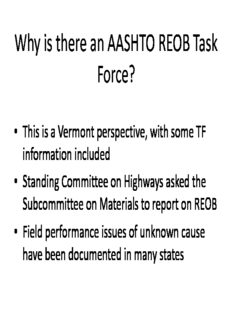
Why is there an AASHTO REOB Task Force? PDF
Preview Why is there an AASHTO REOB Task Force?
Why is there an AASHTO REOB Task Force? • This is a Vermont perspective, with some TF information included • Standing Committee on Highways asked the Subcommittee on Materials to report on REOB • Field performance issues of unknown cause have been documented in many states Has your state received PG Binder modified with REOB? 44.1% Yes - If Yes - Please go to question 5. No - If no - Please skip to question 6. 58.8% SCOH Charge* • Identify research efforts and knowledge • Define REOB use and state awareness, controls • Practices for REOB identification & quantification • Recommended additional research • Risk assessment of state’s specifications *simplified 1) Past, current and upcoming research efforts regarding the use of REOB in asphalt pavements, including the scope and timing of the research • Hesp, D’Angelo, FHWA (Arnold, Gibson), ON (Lane, Marks et al) • Related research on aging including non-oxidative changes is relevant • Research examined modified aging with two distinct results, extended durations and cyclic events (P,T) • Expectations for “a smoking gun” are unlikely to be possible because of the complexity of manufacturing processes, variability of crude oils and variability of REOB are too numerous • Inferential proof such as field performance of asphalts with REOB has shown reduced pavement life at “high” percentages 2) The status of the utilization of REOB in liquid asphalt across State DOTs including knowledge of presence, pertinent specifications pertaining to its use and existing certification or testing requirements if REOB is allowed • Most states assumed that PG Binders did not include other materials without disclosure based on the Standard Specification for Asphalt Binder AASHTO M-320 • M-320 5.1 “Asphalt shall be prepared by the refining of crude petroleum by suitable methods, with or without the addition of modifiers.” • M-320 5.2 “Modifiers may be any organic material of suitable manufacture that is used in virgin or recycled condition…” • 9 states prohibit; 1 state allows, 2 State / Province conditionally allow; 25 states have no REOB specific language 1) How does your state address Recycled Engine Oil Bottoms (REOB) in asphalt binder? 2.4% Approve Prohibit 22.0% Conditionally 4.9% Approve No Specific REOB 70.7% Control 3) Best practices for the identifying the presence and amounts of REOB in asphalt pavements • Modifiers can be identified by formulary reporting or testing at acceptance • Testing is currently semi-quantitative by inferring composition from metals in used engine oil • Ash testing has been in use in CA for nearly a decade with restrictions of < 1% or 0.8% (ON, QC) • X-ray Fluorescence determines metal ion concentrations which are used to estimate engine oil content • Many modifiers are blind to conventional testing based on the complexity of asphalts 4) Recommended additional research necessary to fully evaluate the allowance of REOB into asphalt pavement treatments, or mitigation of its use if necessary • Build an accurate description of REOB in asphalts by multi- laboratory study • Full scale deployment of Turner-Fairbanks method using XRF; pilot scale deployment of ashing • Examine aging mechanism and sample conditioning to simulate aging for sensitivity to duration and cycling • Evaluate surrogate tests including AASHTO TPXX-16 Double Edge Notch Test, adhesion or other proposals with ETG and industry participation Is your state involved in REOB research ? 70.0% 60.0% 50.0% 40.0% 30.0% 20.0% 10.0% 0.0% State Staff Led University Led No Research 5) Preliminary risk assessment of member States' asphalt binder specification and associated recommendations • Existing binder evaluation criteria are not predictive of current failures and provide greater flexibility for Binders than extended aging test results. • Differences in interpretation of standards, especially the term modifier leave states uninformed about binder components. • Modifiers have been identified as key components of PG Binders previously, with a standard AASHTO R-15 for approval. The standard is not actively used. • Field performance has been identified as a major concern for States with two specific issues – premature cracking and atypical raveling. The failures are not known to be exclusively caused by REOB based on current research.
Description: